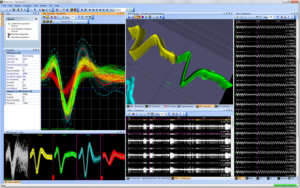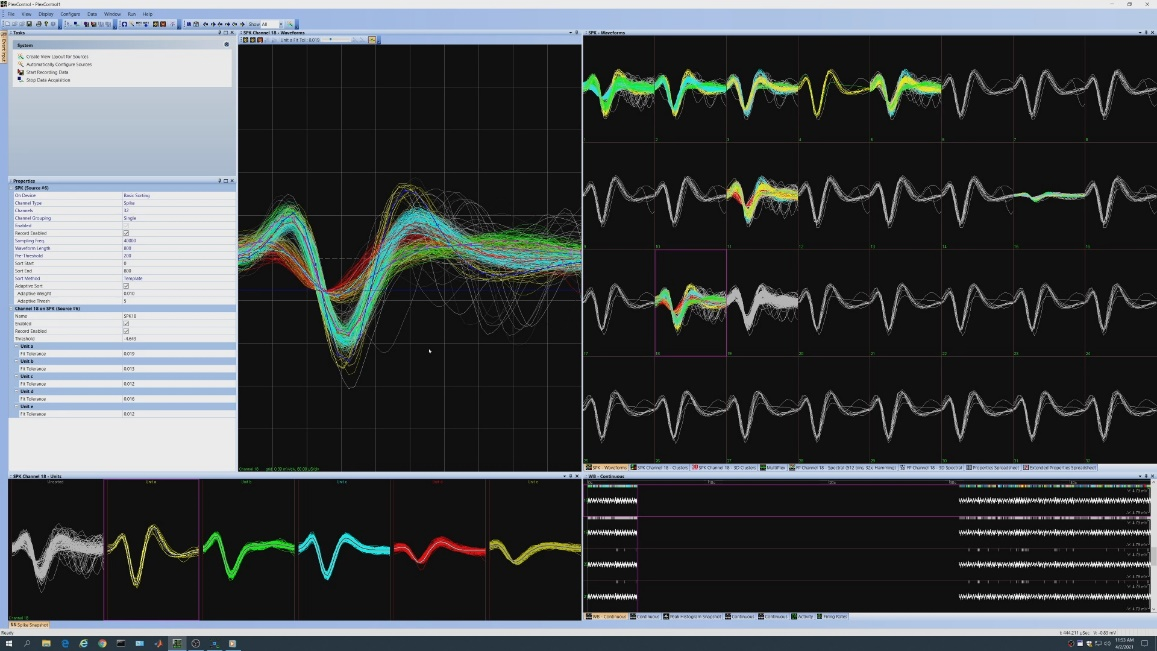
Products
We provide quality service to our customers
产品名称OmniPlex Neural Recording Data Acquisition System
OmniPlex® Neural Recording Data Acquisition System is Plexon’s flagship electrophysiology (a.k.a. ephys) research system. This system combines front-end amplification and acquisition with intuitive and powerful control and visualization software.
Demos
OmniPlex Version 1.20.0 Demo
Latest Software Downloads
OmniPlex Release 20.1 – Windows 7 and Windows 10* Post date August 2021
The OmniPlex System is a compact, flexible platform for high performance data acquisition and powerful online spike sorting. It offers low latency, superior common-mode rejection amplification and is well known for its user-friendliness. The OmniPlex System is a combination of the OmniPlex chassis, OmniPlex Software, and for new OmniPlex systems purchased today, a Digital Headstage Processor (DHP) subsystem – all described below. Other versions of the OmniPlex system could utilize an OmniAmp or DigiAmp A/D device.
- The compact OmniPlex chassis is available in two sizes, Rack Mounted and Table Top, and houses cards for synchronization and timing between system components, acquisition subsystem links, digital inputs, and auxiliary analog inputs for non-neural experiment signals.

- The OmniPlex System Controller operates the OmniPlex Software consisting of OmniPlex Server, the “software engine” for neural signal processing, and PlexControl, which is the main user interface providing data visualization and the user interface for interacting with the system.
- The Digital Headstage Processor (DHP) for use with digital headstages is Plexon’s most advanced subsystem. The DHP now enables up to 512 channels of neural recording, decreased sensitivity to ambient electrical noise, and lighter headstage cables with fewer wires for greater freedom of animal movement. Further, it offers real-time upsampling to 40KHz and adjustment of multiplexer timing offsets (equivalent to simultaneous sampling) for improved sorting quality, trodal acquisition and software referencing – unlike other digital headstage based systems. Alternatively, the predecessor to the DHP is Plexon’s DigiAmp™ subsystem for analog headstages. The DigiAmp Digitizing Amplifier is available in two sizes: the MiniDigi™ for 16, 32, 48 and 64 channels, and the DigiAmp for 64, 128, 192 and 256 channels. This subsystem is recommended when using analog headstages. Both provide 16-bit A/D conversion at 40kHz per channel for acquisition of the complete wide-band signal. Flexible digital filtering supports a wide variety of filter types (Bessel, Butterworth, Elliptic, 2-12 poles, plus adaptive power line noise filter) and cutoff frequencies, for extracting spikes and field potentials from the wide-band signal and for noise removal.
- The DHP and the DigiAmp digitizing amplifier are both electrically isolated.
Sorted spike and continuous data acquired by the OmniPlex System is available to external clients (developed through the C/C++ or MATLAB® software development kits (SDKs)) as soon as 1-2 milliseconds after acquisition. This figure is the actual end-to-end latency through the entire OmniPlex System from spike detection input to hardware output, including an online user client program.
The DigiAmps and all modules in the chassis are synchronized via a high-resolution master timing module. The same master timing module can be extended to synchronize timestamps with compatible equipment such as Plexon’s CinePlex® Behavioral Research System.
Plexon offers a variety of analog and digital headstages for various acute or chronic research needs that are suitable for both large and small animals. Including new 64 and the 128 channel high channel count digital headstages with novel Samtec connectors.
Headstage cables are available in a variety of options including: wire gauge, cable wraps, lengths, connectors and configurations. The proper build will improve the quality of your recordings as well as protect your investment. All Plexon headstage cables are reusable.
Plexon offers a range of robust, low-torque commutators that dependably keep multiple types of cables untangled. Commutators have been engineered to optimize signal transfer with specific designs for use with analog headstages, digital headstages and/or optogenetics.
Learn more about the the powerful online spike sorting software for the OmniPlex System that has a flexible and customizable main user interface.
A Plexon Sales Engineer is happy to discuss your needs and how the OmniPlex could best support your ephys research goals.
PlexControl

PlexControl is the powerful online spike sorting software for the OmniPlex System that has a flexible and customizable main user interface. The software represents the next generation in signal visualization and easy-to-use spike waveform classification methods, and allows the researcher to interact with the system. It features easy-to-use signal visualization, spike detection and sorting algorithms. Many spike sorting methods are available including: box, template, line, band sorting in time/voltage space and contour sorting in PCA feature space. A spike waveform snapshot of user-defined size is automatically acquired on each channel by the PlexControl program, and may be viewed at any time to revise spike sorting parameters as necessary. Units can be defined based on either snapshots of the live data or by “drawing” directly on the live data in real time. Each method may be used to sort single electrodes, stereotrodes and tetrodes online.
Continuous spike, field potential and wide-band signals are conveniently displayed in PlexControl’s flexible, customizable user interface along with detected spike waveform segments and their associated two-dimensional (2D) and three-dimensional (3D) feature space clusters for online spike sorting. Additionally, all three data types, as well as thresholded spike waveform segments and digital event data, may be recorded to disk on a per-channel basis.

Check out some of the highlighted features of the software
Ability to Swap Selected Units
OmniPlex Server
The OmniPlex Server is the “engine” under PlexControl. It visually displays each of the various hardware devices (e.g., headstages, amplifier) and software modules (e.g., spike and LFP separators, thresholding, sorting) of the system. It acquires data from the OmniPlex chassis and amplifiers, sends commands to those devices, and implements the software digital signal processing (DSP) for OmniPlex’s filtering, spike detection and spike sorting functions. OmniPlex Server is based on a modular, extensible framework – or topology – hardware and software devices, which are interconnected in a dataflow topology that utilizes a topology wizard to enable users to easily define custom configurations without tedious low-level editing.
The OmniPlex Software is compatible with Plexon’s MATLAB® and C/C++ APIs and Client Development Kits (SDKs), and the online NeuroExplorer® link – enabling low latency, closed-loop experiments and online analysis of live data. It can also be further enhanced by Plexon’s PlexNet protocol supporting remote online data access across any TCP/IP or UDP network, and PlexUtil for modifying the OmniPlex Software output .PLX data files. Additionally, flexible digital filtering functionality in OmniPlex is also incorporated in the Offline Sorter program, enabling the user to apply the same filters offline to continuously sampled data as is used online.
OmniPlex Software, arrives pre-loaded on the control computer with the purchase of any OmniPlex System. A demo version of the OmniPlex Software, which can be run without the OmniPlex hardware, is available at the top of this page.
Publications
- Duan S. A Substantia Innominata-midbrain Circuit Controls a General Aggressive Response.
- Moaddab M, Ray MH, McDannald MA. Ventral pallidum neurons dynamically signal relative threat. Communications biology. 2021 Jan 8;4(1):1-4.
- Rahimi-Nasrabadi H, Jin J, Mazade R, Pons C, Najafian S, Alonso JM. Image luminance changes contrast sensitivity in visual cortex. Cell reports. 2021 Feb 2;34(5):108692.
- Clawson B, Pickup E, Ensing A, Geneseo L, Shaver J, Gonzalez-Amoretti J, Zhao M, York AK, Jiang S, Aton S. Causal role for sleep-dependent reactivation of learning-activated sensory ensembles for fear memory consolidation. bioRxiv. 2020 Jan 1.
- Phillips RS, Rosner I, Gittis AH, Rubin JE. The effects of chloride dynamics on substantia nigra pars reticulata responses to pallidal and striatal inputs. Elife. 2020 Sep 7;9:e55592.
- PU ME, UCBL LP. L’étude des corrélations du bruit pendant la flexibilité cognitive et de leur régulation pharmacologique par la norépinephrine.
- Stylianou M, Zaaimi B, Thomas A, Taylor JP, LeBeau FE. Early Disruption of Cortical Sleep-Related Oscillations in a Mouse Model of Dementia With Lewy Bodies (DLB) Expressing Human Mutant (A30P) Alpha-Synuclein. Frontiers in Neuroscience. 2020 Sep 17.
- Tang C, Herikstad R, Parthasarathy A, Libedinsky C, Yen SC. Minimally dependent activity subspaces for working memory and motor preparation in the lateral prefrontal cortex. Elife. 2020 Sep 9;9:e58154.
- Wang H, Liu J, Lu Z, Dai Y, Xie J, Xu S, Song Y, Xiao G, Gao F, Qu L, Cai X. Implanted multichannel microelectrode array for simultaneous electrophysiological signal detection of hippocampal CA1 and DG neurons of simulated microgravity rats. Biochemical and Biophysical Research Communications. 2020 Oct 20;531(3):357-63.
- Wang PY, Boboila C, Chin M, Higashi-Howard A, Shamash P, Wu Z, Stein NP, Abbott LF, Axel R. Transient and Persistent Representations of Odor Value in Prefrontal Cortex. Neuron. 2020 Aug 21.
- An J. Towards the clinical translation of a physiological closed-loop control system for precise control of propofol-induced pharmacological coma (Doctoral dissertation, Massachusetts Institute of Technology).
- Albertini D, Gerbella M, Lanzilotto M, Livi A, Maranesi M, Ferroni CG, Bonini L. Connectional gradients underlie functional transitions in monkey pre-supplementary motor area. Progress in neurobiology. 2019 Sep 23:101699.
- Ahrens AM, Ferguson LM, Robinson TE, & Aldridge JW. Dynamic Encoding of Incentive Salience in the Ventral Pallidum: Dependence on the Form of the Reward Cue. Eneuro,2018 April 25; 5(2).
- Astrand E, Wardak C, Hamed SB. Neuronal population correlates of target selection and distractor filtering. bioRxiv. 2018 Jan 1:422873.
- Deku F, Cohen Y, Joshi-Imre A, Kanneganti A, Gardner TJ, & Cogan SF. Amorphous silicon carbide ultramicroelectrode arrays for neural stimulation and recording. Journal of Neural Engineering, 2018 Jan 8; 15(1).
- Deku F, Frewin C, Stiller A, Cohen Y, Aqeel S, Joshi-Imre A, Black B, Gardner T, Pancrazio J, Cogan S. Amorphous Silicon Carbide Platform for Next Generation Penetrating Neural Interface Designs. Micromachines. 2018 Sep 20;9(10):480.
- Anand S, Desai V, Alsmadi N, Kanneganti A, Nguyen DH, Tran M, Patil L, Vasudevan S, Xu C, Hong Y, Cheng J. Asymmetric Sensory-Motor Regeneration of Transected Peripheral Nerves Using Molecular Guidance Cues. Scientific reports. 2017 Oct 30;7(1):14323.
- Babapoor-Farrokhran S, Vinck M, Womelsdorf T, Everling S. Theta and beta synchrony coordinate frontal eye fields and anterior cingulate cortex during sensorimotor mapping. Nature communications. 2017 Feb 7;8:13967.
- Beckert MV, Pavão R, Peña JL. Distinct Correlation Structure Supporting a Rate-Code for Sound Localization in the Owl’s Auditory Forebrain. eNeuro. 2017 May 1;4(3):ENEURO-0144.
- Bichot NP, Heard MT, DeGennaro EM, Desimone R. A source for feature-based attention in the prefrontal cortex. Neuron. 2015 Nov 18;88(4):832-44.
- Dolzani SD, Baratta MV, Amat J, Agster KL, Saddoris MP, Watkins LR, Maier SF. Activation of a Habenulo–Raphe Circuit Is Critical for the Behavioral and Neurochemical Consequences of Uncontrollable Stress in the Male Rat. eNeuro. 2016 Sep 1;3(5):ENEURO-0229.
- Gamble-George JC, Baldi R, Halladay L, Kocharian A, Hartley N, Silva CG, Roberts H, Haymer A, Marnett LJ, Holmes A, Patel S. Cyclooxygenase-2 inhibition reduces stress-induced affective pathology. Elife. 2016;5.
- Giustino TF, Fitzgerald PJ, Maren S. Fear expression suppresses medial prefrontal cortical firing in rats. PloS one. 2016 Oct 24;11(10):e0165256.
- Aravamuthan BR, Shoykhet M. Long-term increase in coherence between the basal ganglia and motor cortex after asphyxial cardiac arrest and resuscitation in developing rats. Pediatric research. 2015 Oct;78(4):371.
- Bigdeli S, Dettloff RO, Frank CW, Davis RW, Crosby LD. A simple method for encapsulating single cells in alginate microspheres allows for direct PCR and whole genome amplification. PloS one. 2015 Feb 17;10(2):e0117738.
- Desai VH, Anand S, Tran M, Kanneganti A, Vasudevan S, Seifert JL, Cheng J, Keefer EW, Romero-Ortega MI. Chronic sensory-motor activity in behaving animals using regenerative multi-electrode interfaces. InEngineering in Medicine and Biology Society (EMBC), 2014 36th Annual International Conference of the IEEE 2014 Aug 26 (pp. 1973-1976). IEEE.
- Dhakal KR, Gu L, Shivalingaiah S, Dennis TS, Morris-Bobzean SA, Li T, Perrotti LI, Mohanty SK. Non-scanning fiber-optic near-infrared beam led to two-photon optogenetic stimulation in-vivo. PloS one. 2014 Nov 10;9(11):e111488.
- David F, Schmiedt JT, Taylor HL, Orban G, Di Giovanni G, Uebele VN, Renger JJ, Lambert RC, Leresche N, Crunelli V. Essential thalamic contribution to slow waves of natural sleep. Journal of Neuroscience. 2013 Dec 11;33(50):19599-610.
- Jennings JH, Sparta DR, Stamatakis AM, Ung RL, Pleil KE, Kash TL, Stuber GD. Distinct extended amygdala circuits for divergent motivational states. Nature. 2013 Apr;496(7444):224.
- Navawongse R, Eichenbaum H. Distinct pathways for rule-based retrieval and spatial mapping of memory representations in hippocampal neurons. Journal of Neuroscience. 2013 Jan 16;33(3):1002-13.
- Zhao F, Li M, Qian Y, Tsien JZ. Remote measurements of heart and respiration rates for telemedicine. PloS one. 2013 Oct 8;8(10):e71384.



Address: Hualong building, building 3, No. 29,
North Third Ring Road, Xicheng District, Beijing
Tel:400-088-1922
Copyright (C) 2020 Hong Kong Plexon All rights reserved 京ICP备14048516号








 taobao
taobao Tel connect
Tel connect